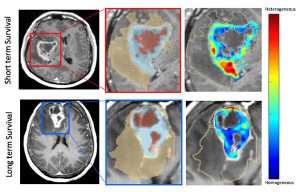Scientists Discover New Methods for Tackling Glioblastoma
Scientists at Case Western Reserve University have come up with a unique approach to determine the prognosis of glioblastoma using two types of analysis: computer imaging analysis and genomic research. As described in AAAS, combining these two methods can not only determine the life expectancy of the patient, but can also identify which patients could qualify for clinical trials.
What is glioblastoma?
Glioblastoma accounts for roughly 15% of brain tumors and is the fastest growing brain tumor known to date. Many patients rarely survive more than a couple of years after being diagnosed, and only about 10% go on to survive more than three years.
Glioblastoma is one of the most common types of brain cancer. It is a type of glioma found in brain cells known as astrocytes (astrocytomas).
MRI Images and gene expression analysis

An example of the MRI scans showing long-term and short-term survival indications. Credit: Case Western Reserve University
Typically, scientists will analyze MRI images or genomic information to diagnose and find the optimal treatment options for cancer patients. However, this study conducted by Case Western scientists is revolutionary in that they used both MRI images and gene expression in conjunction to further enhance their research.
Using artificial intelligence (AI), scientists can identify which patients have a poor prognosis by looking within the tumor and the regions around it. Next, they use gene expression data to correlate the biological pathways with tumor heterogeneity. Once both pieces of the puzzle are mapped together, they can better understand which biological pathways closely align with the MRI images.
Further, the images gathered from the study depicted poor prognosis with pathways that resist chemotherapy. Medical doctor Manmeet Ahluwali, co-author of the study, added that “…You could know whether you’ll respond to chemotherapy well or immunotherapy, based on a patient’s image and gene profiles.” This type of finding is valuable and will allow clinicians to select alternative treatment plans such as immunotherapy or targeted therapy.
In conclusion, combining both AI and gene expression allows clinicians to give a more accurate diagnosis for patients than using each method of analysis alone. This is important and groundbreaking as it could help clinicians give patients a better quality of life.
Related Research
Do you work in the field of research? If so, you may be interested in viewing our other reagents that might be related to brain cancer research. Some of the reagents include:


